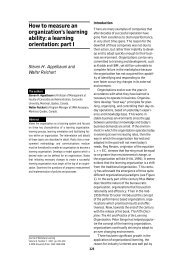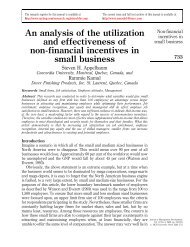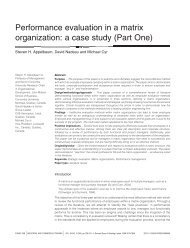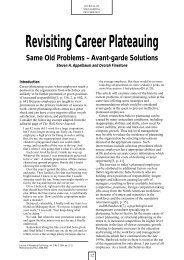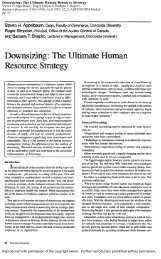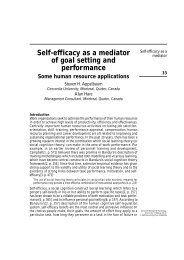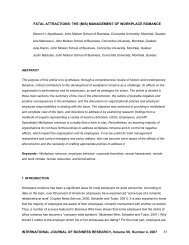Back to the future: revisiting Kotter's - Dr. Steven H. Appelbaum ...
Back to the future: revisiting Kotter's - Dr. Steven H. Appelbaum ...
Back to the future: revisiting Kotter's - Dr. Steven H. Appelbaum ...
Create successful ePaper yourself
Turn your PDF publications into a flip-book with our unique Google optimized e-Paper software.
The current issue and full text archive of this journal is available at<br />
www.emeraldinsight.com/0262-1711.htm<br />
JMD<br />
31,8<br />
764<br />
<strong>Back</strong> <strong>to</strong> <strong>the</strong> <strong>future</strong>: <strong>revisiting</strong><br />
Kotter’s 1996 change model<br />
<strong>Steven</strong> H. <strong>Appelbaum</strong><br />
John Molson School of Business, Concordia University, Montreal, Canada<br />
Sally Habashy<br />
P \S \L Group, Montreal, Canada<br />
Jean-Luc Malo<br />
Ergoplan, Montreal, Canada, and<br />
Hisham Shafiq<br />
Oracle Corporation, Montreal, Canada<br />
Abstract<br />
Purpose – The purpose of this paper is <strong>to</strong> ga<strong>the</strong>r current (2011) arguments and counterarguments in<br />
support of <strong>the</strong> classic change management model proposed by John P. Kotter in his 1996 book Leading<br />
Change. His work was based on his personal business and research experience, and did not reference<br />
any outside sources that has questioned its value. A current perspective on a limited tested model aims<br />
<strong>to</strong> be a focus of this paper.<br />
Design/methodology/approach – The literature on change management was reviewed for each of<br />
<strong>the</strong> eight steps defined in Kotter’s model, <strong>to</strong> review how much support each of <strong>the</strong>se steps had,<br />
individually and collectively, in 15 years of literature.<br />
Findings – The review found support for most of <strong>the</strong> steps, although no formal studies were found<br />
covering <strong>the</strong> entire spectrum and structure of <strong>the</strong> model. Kotter’s change management model appears<br />
<strong>to</strong> derive its popularity more from its direct and usable format than from any scientific consensus on<br />
<strong>the</strong> results. However <strong>the</strong> model has several limitations, that are identified, impacting upon its universal<br />
acceptance and popularity.<br />
Research limitations/implications – Fur<strong>the</strong>r studies should examine <strong>the</strong> validity of Kotter’s model<br />
as a whole. More importantly, change management research should form a greater link with<br />
stakeholders in order <strong>to</strong> translate current research in<strong>to</strong> a format usable by practitioners.<br />
Practical implications – No evidence was found against Kotter’s change management model<br />
and it remains a recommendable reference. This paper attempts <strong>to</strong> “test” <strong>the</strong> “how-<strong>to</strong>-do-change<br />
management” with empirical and practitioner literature that was not evident in <strong>the</strong> original text. The<br />
model would be most useful as an implementation planning <strong>to</strong>ol, but complementary <strong>to</strong>ols should also<br />
be used during <strong>the</strong> implementation process <strong>to</strong> adapt <strong>to</strong> contextual fac<strong>to</strong>rs or obstacles.<br />
Originality/value – Based upon a thorough review, this is <strong>the</strong> first formal review of Kotter’s change<br />
management model, 15 years after its introduction.<br />
Keywords Change management, Organizational change, Corporate strategy, Empowerment,<br />
Engagement, Vision, Management<br />
Paper type Conceptual paper<br />
Journal of Management Development<br />
Vol. 31 No. 8, 2012<br />
pp. 764-782<br />
r Emerald Group Publishing Limited<br />
0262-1711<br />
DOI 10.1108/02621711211253231<br />
Introduction<br />
Businesses are constantly required <strong>to</strong> adapt <strong>to</strong> a changing environment in order <strong>to</strong><br />
maintain <strong>the</strong>ir position in <strong>the</strong> market and even more so if <strong>the</strong>y are <strong>to</strong> truly grow<br />
(Biedenbacha and Soumlderholma, 2008). Changes are an inevitable part of <strong>the</strong> current<br />
market. The current rate of technological advancement and growing global<br />
competition lets us foresee a continuing need for change in <strong>the</strong> <strong>future</strong> (Armenakis<br />
and Harris, 2009). Many authors argue that change never starts because it never s<strong>to</strong>ps<br />
(Weick and Quinn, 1999). Many organizations, in an attempt <strong>to</strong> adapt <strong>to</strong> <strong>the</strong> constant



